Related Research Articles
No. 44 Wing is a Royal Australian Air Force (RAAF) wing responsible for providing air traffic control services to the Australian Defence Force. It directly commands two squadrons, which in turn command eleven air traffic control flights located across the country at nine RAAF bases, HMAS Albatross and Oakey Army Aviation Centre. The wing was formed during World War II, in December 1942, and was disbanded in August 1944. It was re-established in its current form in November 2000.

North-Eastern Area Command was one of several geographically based commands raised by the Royal Australian Air Force (RAAF) during World War II. For most of its existence it controlled units based in central and northern Queensland as well as Papua New Guinea. It was formed in January 1942 from the eastern part of the former Northern Area Command, which had covered all of northern Australia and Papua. Headquartered at Townsville, Queensland, North-Eastern Area Command's responsibilities included air defence, aerial reconnaissance and protection of the sea lanes within its territory. Its flying units, equipped with fighters, reconnaissance bombers, dive bombers and transports, took part in the battles of Rabaul, Port Moresby and Milne Bay in 1942, and the landings at Hollandia and Aitape in 1944.
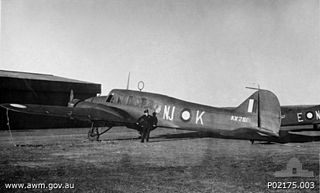
No. 73 Squadron was a Royal Australian Air Force (RAAF) maritime patrol squadron of World War II. It was formed in July 1942 and conducted patrols off the east coast of Australia until July 1944. The squadron was disbanded in September 1944.

Air Vice Marshal William Dowling Bostock, was a senior commander in the Royal Australian Air Force (RAAF). During World War II he led RAAF Command, the Air Force's main operational formation, with responsibility for the defence of Australia and air offensives against Japanese targets in the South West Pacific Area. His achievements in the role earned him the Distinguished Service Order and the American Medal of Freedom. General Douglas MacArthur described him as "one of the world's most successful airmen".
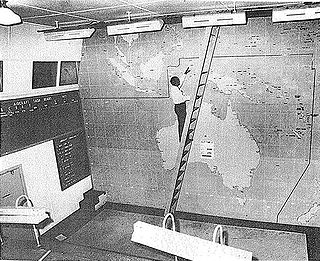
The Bankstown Bunker, formerly known as Air Defence Headquarters Sydney, is a heritage-listed defunct Royal Australian Air Force (RAAF) operations facility, located on the corner of Marion and Edgar Street, in Condell Park, New South Wales, Australia. It was designed by the Allied Works Council and built from 1943 to 1944 by Stuart Bros Pty Ltd of Sydney. It is also known as Air Defence Headquarters Ruin Sydney (former), No. 1 Fighter Section Headquarters, 1FSHQ, Bankstown Bunker and RAAF No. 1 Installation Bankstown; No. 101 Fighter Sector. It was added to the New South Wales State Heritage Register on 18 November 2011.
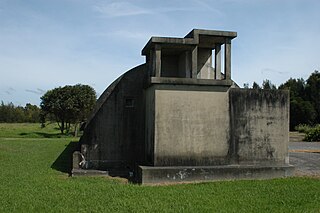
No. 131 Radar Station RAAF is a heritage-listed former Royal Australian Air Force radar station at Kooragang, City of Newcastle, New South Wales, Australia. They are also known as the Radar Igloo and Radar Buildings. They now operate as the Estuarine Interpretive Centre.

No. 208 Radar Station RAAF is a heritage-listed former Royal Australian Air Force (RAAF) radar station at Mine Camp at Catherine Hill Bay and Pinny Beach, both in City of Lake Macquarie, New South Wales, Australia. It was established on 10 February 1943. The remains of the radar station were added to the New South Wales State Heritage Register on 22 July 2008.
No. 1 Fighter Sector (1FS) was a Royal Australian Air Force (RAAF) unit formed at Bankstown, New South Wales on 25 February 1942.
RAAF Bradfield Park was a Royal Australian Air Force (RAAF) station located at the former suburb of Bradfield Park, New South Wales during World War II.

Fenton Airfield was a World War II military airfield in the Northern Territory of Australia located at Tipperary Station in what is now the locality of Douglas-Daly and named after flight lieutenant Clyde Fenton.
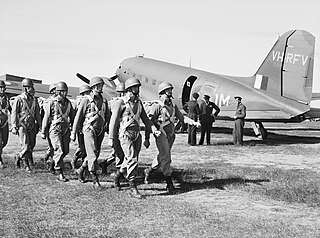
The Paratroop Training Unit (PTU) was a unit of the Royal Australian Air Force (RAAF) during World War II, which served as the instruction centre for recruitment and training of the Australian Army paratroopers. Trainees mostly came from the 1st Parachute Battalion and Z Special Unit.
No. 19 Radar Station RAAF was a Royal Australian Air Force radar station formed at Bombi near Bouddi, New South Wales, Australia on 15 April 1942.
No. 17 Radar Station RAAF was a Royal Australian Air Force radar station formed at Burrewarra Point, Guerilla Bay, New South Wales, Australia on 12 April 1943. The radar became operational on 29 April 1943 after initial training and setting up the radar equipment.
No. 20 Radar Station RAAF was a Royal Australian Air Force radar station formed at Nelson Bay, New South Wales, Australia, during World War II on 12 April 1942. The radar station was set up upon Tomaree Head, Port Stephens and became operational on 1 June 1942.

Air Vice Marshal Henry Neilson Wrigley, CBE, DFC, AFC was a senior commander in the Royal Australian Air Force (RAAF). A pioneering flyer and aviation scholar, he piloted the first trans-Australia flight from Melbourne to Darwin in 1919, and afterwards laid the groundwork for the RAAF's air power doctrine. During World War I, Wrigley joined the Australian Flying Corps and saw combat with No. 3 Squadron on the Western Front, earning the Distinguished Flying Cross; he later commanded the unit and published a history of its wartime exploits. He was awarded the Air Force Cross for his 1919 cross-country flight.

No. 5 Elementary Flying Training School was a Royal Australian Air Force (RAAF) pilot training unit that operated during World War II. It was one of twelve elementary flying training schools employed by the RAAF to provide introductory flight instruction to new pilots as part of Australia's contribution to the Empire Air Training Scheme. No. 5 EFTS was established in June 1940 at Narromine, New South Wales, and primarily operated Tiger Moths. It ceased training in June 1944, after more than 3,700 students had passed through.
John Hipwell was an Australian architect who practised and designed mainly in Warrandyte, Victoria, Australia. He worked with Fritz Janeba and was the longest surviving member of Hipwell, Weight and Mason Architects. He also served in Papua New Guinea as Commanding Officer of radar unit 334 with the R.A.A.F. during the Second World War.

No. 227 Radar Station RAAF was a Royal Australian Air Force radar station located at Yanchep, Western Australia. Established during World War II to provide early warning of Japanese air raids against Perth, the radar station was formed in 1942–43 and operational by late 1943.

Charlie's Hill Radar Station is a heritage-listed radar station off Charlie's Hill Road, Inkerman, Shire of Burdekin, Queensland, Australia. It was built in 1943 by Royal Australian Air Force. It was added to the Queensland Heritage Register on 23 February 2001.
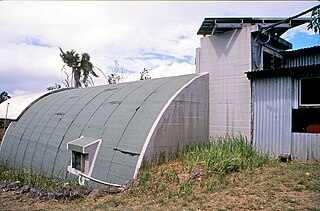
Bones Knob Radar Station is a heritage-listed radar station at Bowcock Road, Tolga, Tablelands Region, Queensland, Australia. It was built in 1943. It is also known as WWII RAAF 220 Radar Station. It was added to the Queensland Heritage Register on 14 May 2010.